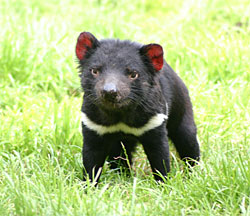 Climate Change Will Significantly Increase Impending Bird Extinctions
Climate Change Will Significantly Increase Impending Bird Extinctions
ScienceDaily - www.sciencedaily.com
07 Dec 2007
Photo courtesy of ScienceDaily
Where do you go when you've reached the top of a mountain and you can't go back down?
It's a question increasingly relevant to plants and animals, as their habitats slowly shift to higher elevations, driven by rising temperatures worldwide. The answer, unfortunately, is you can't go anywhere. Habitats shrink to the vanishing point, and species go extinct.
That scenario is likely to be played out repeatedly and at an accelerating rate as the world continues to warm, Stanford researchers say. By 2100, climate change could cause up to 30 percent of land-bird species to go extinct worldwide, if the worst-case scenario comes to pass. Land birds constitute the vast majority of all bird species.
Environmentalists worry border fence-building will threaten Arizona river
Associated Press (posted by Las Cruces Sun-News – www.lcsun-news.com)
05 Dec 2007
Area: Arizona, USA
. . . The federal government contends the fence is needed to stem the flow of illegal immigrants and drug-runners through the area. Environmentalists say it may slow some illegal crossers but will have a devastating impact on wildlife and the environment in the riparian area that encompasses the river.
Mountain lions, jaguars, white-tailed deer, black bears and some ground birds will be among wildlife especially affected by the fence, which is just some 400 yards from the river at this point, said Matt Clark, a spokesman for Defenders of Wildlife.
"When you construct a barrier across a conservation habitat, you're limiting the ability of a species to find food, habitat and mates, and you're preventing genetic exchange between populations," Clark said.
 Tagged Tasmanian devils hold key for survival
Tagged Tasmanian devils hold key for survivalABC - www.abc.net.au
06 Dec 2007
F Ogilvie
Photo courtesy of Tasmanian Devil Conservation Park
Area: Tasman Peninsula, Australia
MARK COLVIN: There's finally some hope in the battle to save the threatened Tasmanian devil population.
The species is in danger of extinction because of a contagious facial cancer that's spreading across the Island.
But today scientists are releasing a group of Tasmanian devil orphans on the Tasman Peninsula back into the wild.
The orphans will wear high-tech collars through which the scientists can track their movements via satellite.
From the Tasman Peninsula, Felicity Ogilvie reports.
(Sound of Tasmanian devil squealing and snorting)
FELICITY OGILVIE: That's the cry that got the Tasmanian devil it name.
Cargill Partners With Wildlife Conservation Society on Global Animal Health and Food Security
Grain Journal - www.grainnet.com
04 Dec 2007
Cargill and the Wildlife Conservation Society (WCS) have formed a partnership to support global efforts to examine health links among humans, livestock, and wildlife, and to monitor for avian influenza and other diseases shared between people and animals.
Cargill is committing $1.5 million for two initiatives spearheaded by WCS: expanding a global surveillance network for avian influenza in Indonesia and Vietnam, and introducing a grants program for animal health projects in Brazil.
“Food security begins with healthy animals,” said Mike Robach, Vice President of Global Food Safety for Cargill. “We believe that the health of wildlife and livestock are interconnected, and will require a multi-disciplinary approach in order to develop safe and effective food systems.
 The Sea Louse, A Common Parasite Of Wild Fish
The Sea Louse, A Common Parasite Of Wild FishScienceDaily - www.sciencedaily.com
06 Dec 2007
Photo courtesy of ScienceDaily
Øivind Øines has shown in his Ph. D. thesis that the sea louse, a parasitic copepod, is widely distributed among wild fish species along the Norwegian coast. The parasite is found in large numbers in the lumpfish, which is now considered to be one of the primary hosts of the parasite. The lumpfish in turn infects several types of farmed fish when it comes into the coast during the spring months.
. . . “Since sea lice are found on so many different north-Atlantic fish species, it is highly likely that they can transmit from wild fish to farmed fish. Our genetic studies of the parasite also support this. It is also likely that they can transmit between different farmed species”, says Øivind Øines.
OTHER WILDLIFE DISEASE RELATED NEWS
- Electric Boost for Reefs [National Geographic news video]
- Giant pandas under threat from parasitic worm
- Gopher Tortoises: declining habitat and growing threats from predators [Assignment Earth video]
- Future of grouse up in the air: Valley reacts to judge's decision
- 8,000 Toxic Waste Sites Ignored by EPA; Massive Lead Contamination at Shooting Ranges
- New Software To Aid Early Detection of Infectious Disease Outbreaks
- DNR expands deer season in bovine TB zone
- Oregon seeks comment on deer, elk ranch rules: State wants to guard against disease invading wild herds
- Another white tiger dies in Bhopal's national park
- Loa Hatchery placed under quarantine
- State regulations on transporting wildlife to protect local ani[mals]





No comments:
Post a Comment